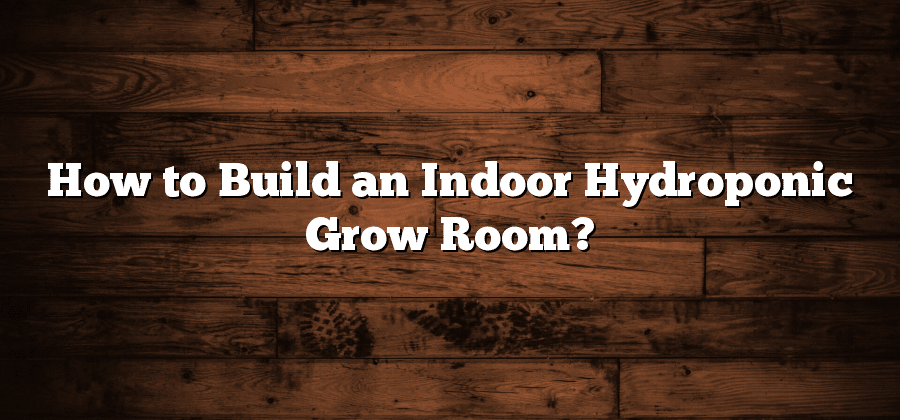Selecting the Ideal Space for Your Indoor Hydroponic Grow Room
Selecting the ideal space for your indoor hydroponic grow room is a crucial step in ensuring the success of your hydroponic setup. When choosing a location, there are several factors to consider. First and foremost, you want to ensure that the area receives sufficient natural light or has access to artificial lighting. Plants require adequate light for photosynthesis, so selecting a space with good lighting conditions is essential for their growth and development.
Another important consideration is the size of the space. Make sure it is large enough to accommodate your desired number of plants and the necessary equipment. It should have enough room for plant trays, reservoirs, pumps, and a system for hanging lights if needed. Additionally, ensure that the space provides easy access for maintenance and monitoring. Remember, a well-designed grow room will enable you to create an optimal environment for your plants, resulting in healthy and abundant yields.
Assessing the Required Lighting for Optimal Plant Growth
When it comes to indoor hydroponic gardening, one of the most critical factors for ensuring optimal plant growth is the right lighting setup. Light acts as the energy source for plants, driving the process of photosynthesis that enables them to produce the necessary nutrients to thrive. Therefore, it is essential to assess and choose the right lighting system to meet the specific needs of your plants.
Firstly, it is crucial to understand the various types of lighting options available for indoor hydroponic gardening. The most commonly used lights are fluorescent, high-intensity discharge (HID), and light-emitting diode (LED) lights. Each of these lighting technologies has its advantages and disadvantages, such as the intensity and spectrum of light they provide, their energy efficiency, and their heat output. By assessing your plants’ requirements and the space available in your grow room, you can determine which lighting option will be most suitable for promoting healthy and robust growth. Remember, selecting the right lighting system is essential for providing your plants with the necessary light spectrum and intensity for their specific growth stages, whether it is for vegetative growth, flowering, or fruiting.
In addition to choosing the right type of lighting technology, it is also crucial to consider the light intensity and duration. Different plant species have different light requirements, with some plants needing higher light intensities than others. It is essential to research and understand the light requirements of your particular plants to provide them with the optimal amount of light. Additionally, it is important to remember that light duration also plays a crucial role in plant growth. Most plants require a certain number of hours of light exposure per day, known as the light cycle or photoperiod. By carefully assessing and adjusting the light intensity and duration, you can create an optimal lighting environment that promotes healthy and vigorous plant growth in your indoor hydroponic grow room.
Choosing the Right Hydroponic System for Your Indoor Grow Room
One of the key decisions that every indoor hydroponic grower must make is choosing the right hydroponic system for their setup. With so many options available in the market, it can be overwhelming to determine which system is the best fit for your needs. However, by understanding the different types of hydroponic systems and their specific advantages and disadvantages, you can make an informed decision that will contribute to the success of your indoor garden.
One popular option for indoor hydroponic systems is the deep water culture (DWC) system. In this system, the plants are suspended in a nutrient-rich water solution with their roots submerged. The oxygen needed for the plants’ respiration is provided through the use of air stones or diffusers. The simplicity of the DWC system makes it an excellent choice for beginners, as it requires minimal knowledge and maintenance. Additionally, the system allows for continuous nutrient uptake by the plants, resulting in fast and healthy growth. However, it is important to note that the DWC system may not be suitable for all types of plants, especially those with sensitive root systems.
Understanding the Importance of Proper Ventilation and Air Circulation
Proper ventilation and air circulation are critical factors for the success of your indoor hydroponic grow room. In a closed environment, it is essential to ensure a constant exchange of air to maintain optimal growing conditions for your plants.
One of the primary reasons why ventilation is important is to control temperature and humidity levels. As plants grow, they release moisture through a process called transpiration. Without adequate airflow, the moisture can accumulate, leading to high humidity levels. High humidity not only promotes the growth of mold and mildew but also creates an ideal environment for pests to thrive. On the other hand, insufficient airflow can cause stagnant air pockets, resulting in temperature imbalances that can stress or even harm your plants.
Selecting the Appropriate Growing Medium for Your Hydroponic Setup
When it comes to selecting the appropriate growing medium for your hydroponic setup, there are several key factors to consider. The growing medium, also known as the substrate, plays a crucial role in supporting plant growth and providing essential nutrients. It acts as a reservoir, holding water and nutrients that are absorbed by the plants’ roots.
One of the most commonly used growing mediums in hydroponics is rockwool. This inert material is made from molten rock or recycled slag that is spun into fibers. Rockwool provides excellent water retention, allowing for optimal moisture levels for plant growth. It also has good air porosity, ensuring that the roots receive the necessary oxygen. Another advantage of rockwool is its ability to be easily sterilized and reused, making it cost-effective in the long run. However, it is important to note that rockwool can have a high pH level initially, so it needs to be properly rinsed and pH adjusted before use.






